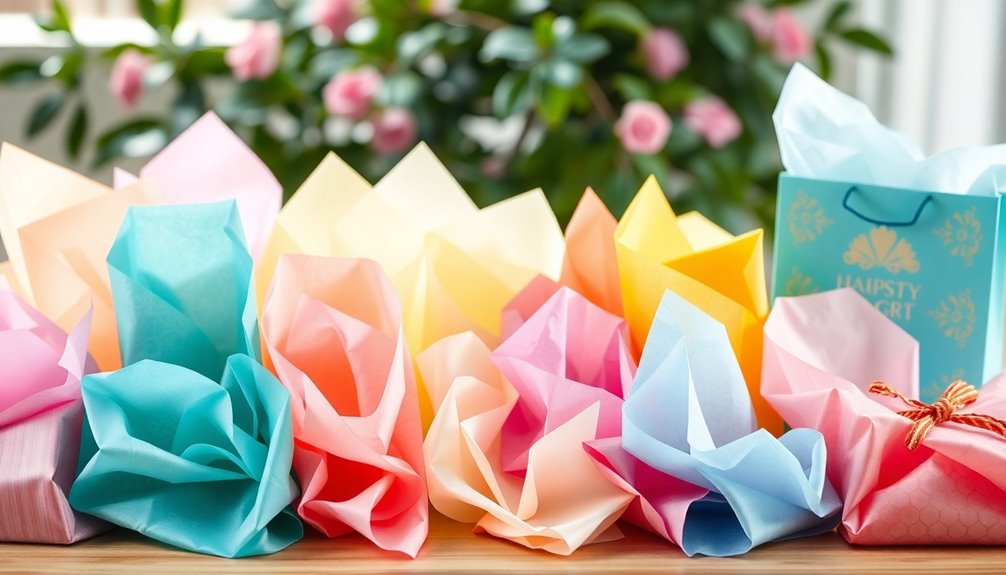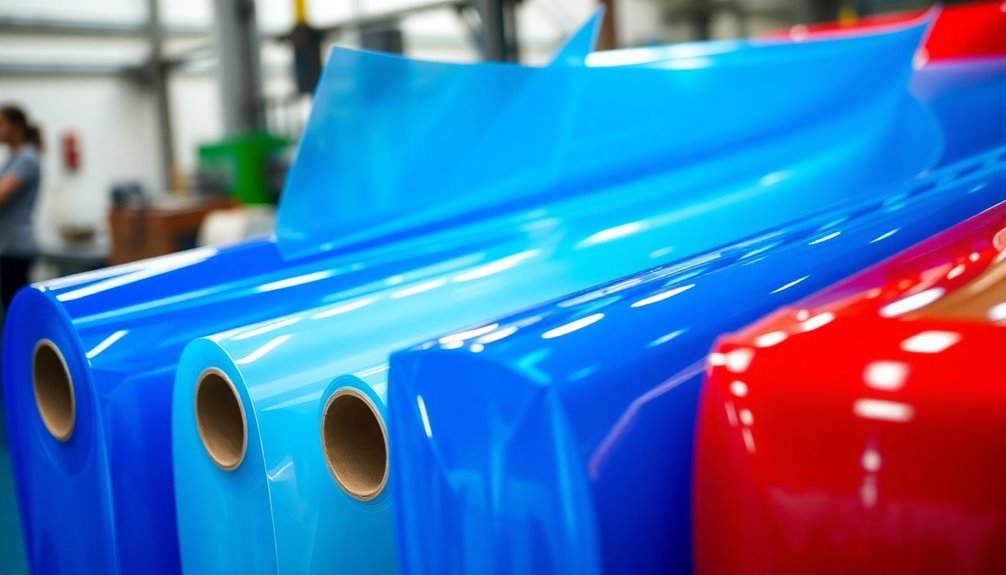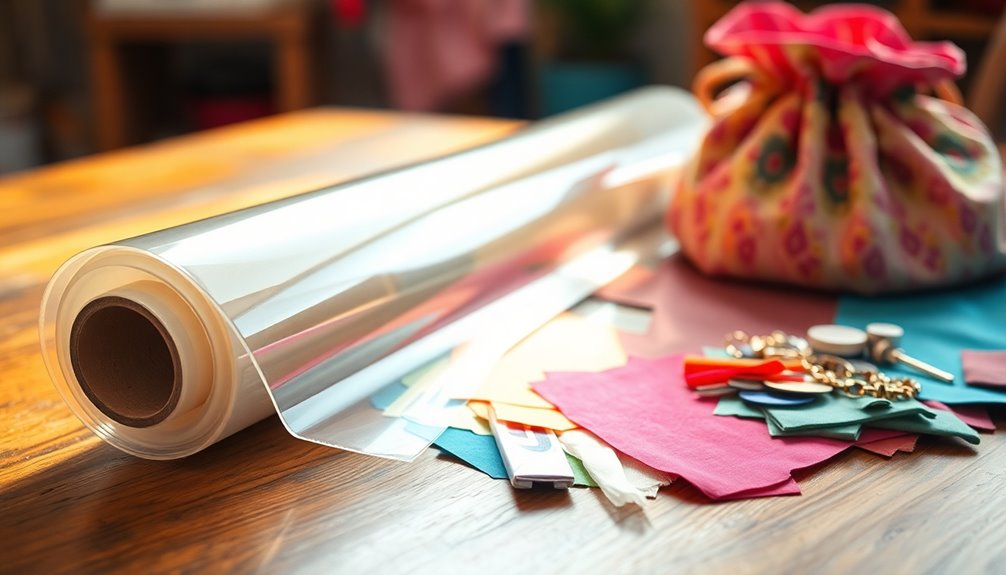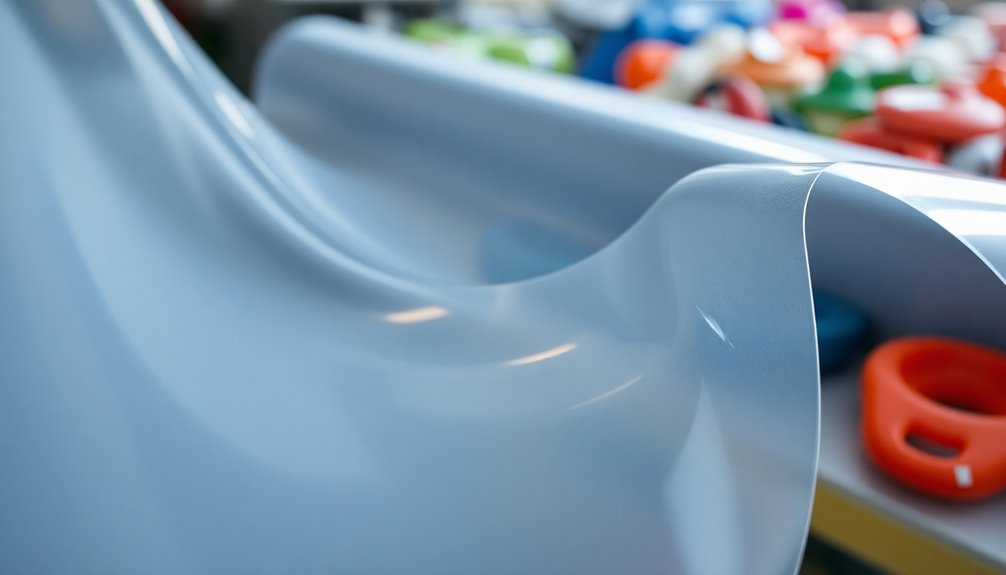Kraft paper is a robust material made from wood pulp through a chemical process that retains its strength and natural brown color. It's eco-friendly because it's 100% biodegradable, recyclable, and sourced from sustainably managed forests. The production process uses fewer chemicals, generating less pollution while being energy-efficient. Plus, kraft paper decomposes quickly, reducing landfill waste compared to plastics. Its versatility makes it perfect for packaging, crafts, and more, appealing to eco-conscious consumers. If you're curious about its specific applications and benefits, there's plenty more to discover about this sustainable choice.
Key Takeaways
- Kraft paper is a strong, durable paper made from wood pulp using the eco-friendly Kraft process, preserving natural fibers.
- It is 100% biodegradable and recyclable, significantly reducing landfill waste compared to plastic products.
- The production process recycles approximately 90% of chemicals, resulting in fewer pollutants and lower energy and water usage.
- Sourced from responsibly managed forests, kraft paper often carries FSC certification, ensuring sustainable forestry practices.
- Its lightweight design reduces shipping costs and carbon emissions, making it a cost-effective and environmentally friendly packaging solution.
Definition of Kraft Paper
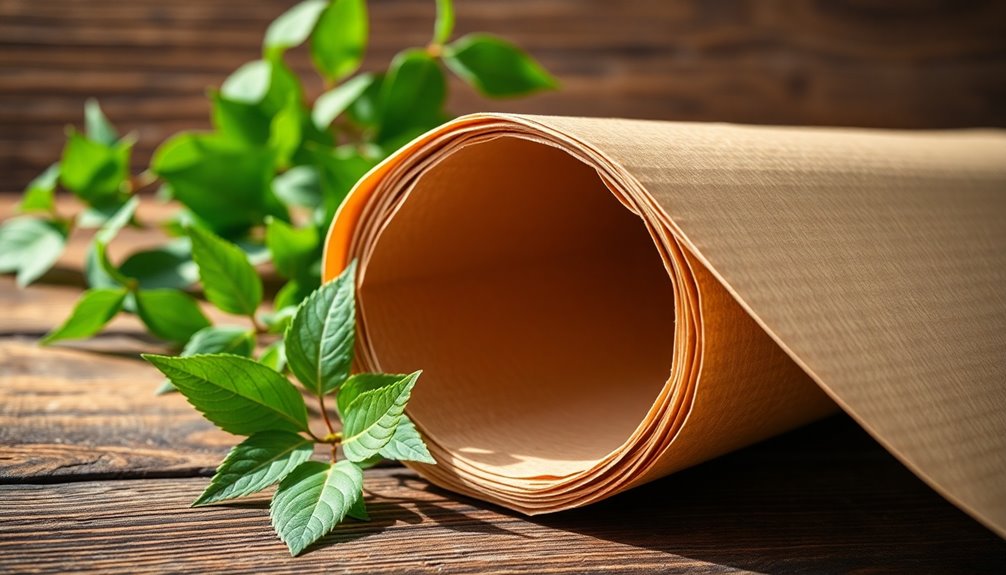
Kraft paper, derived from wood pulp through the Kraft process, is known for its exceptional strength and durability. This method involves cooking wood chips with sodium sulfide and sodium hydroxide, effectively separating lignin from cellulose. The result is a paperboard material recognized for its high tensile strength, making it ideal for various packaging applications.
Often brown in color due to minimal bleaching, kraft paper retains a natural look that appeals to eco-conscious consumers. Its eco-friendly properties enhance its appeal, as it's 100% biodegradable and recyclable. This contributes to reducing waste and promotes a circular economy, aligning perfectly with sustainable packaging initiatives.
Moreover, the unique texture and high porosity of kraft paper allow for effective printing and finishing, making it versatile for branding needs.
Whether you're looking to package products sustainably or to showcase your brand's commitment to the environment, kraft paper serves as an excellent choice.
In a world increasingly focused on sustainability, understanding the definition and benefits of kraft paper can help you make informed decisions about your packaging materials.
Production Process Overview
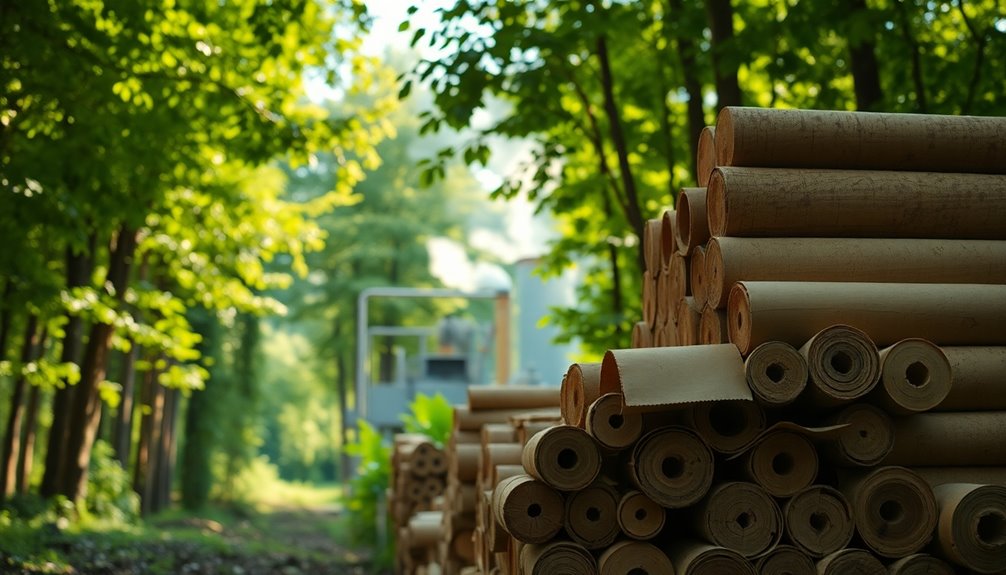
The production of kraft paper involves a highly efficient process that sets it apart from conventional paper manufacturing. In the kraft pulping process, wood chips are pressure-cooked with sodium sulfide and sodium hydroxide, which separates cellulose from lignin. This method considerably enhances the cellulose content, resulting in a stronger paper that outperforms traditional methods that retain more lignin.
One of the standout features of kraft paper production is its sustainability. Approximately 90% of the chemicals used in the pulping process can be recovered and reused, minimizing waste and reducing the environmental impact. This recovery system not only conserves resources but also lowers energy and water requirements compared to conventional techniques.
Additionally, minimal bleaching is applied during production, preserving the paper's natural strength and characteristic brown color. The overall process generates fewer pollutants, making kraft paper a more eco-friendly choice.
Key Characteristics
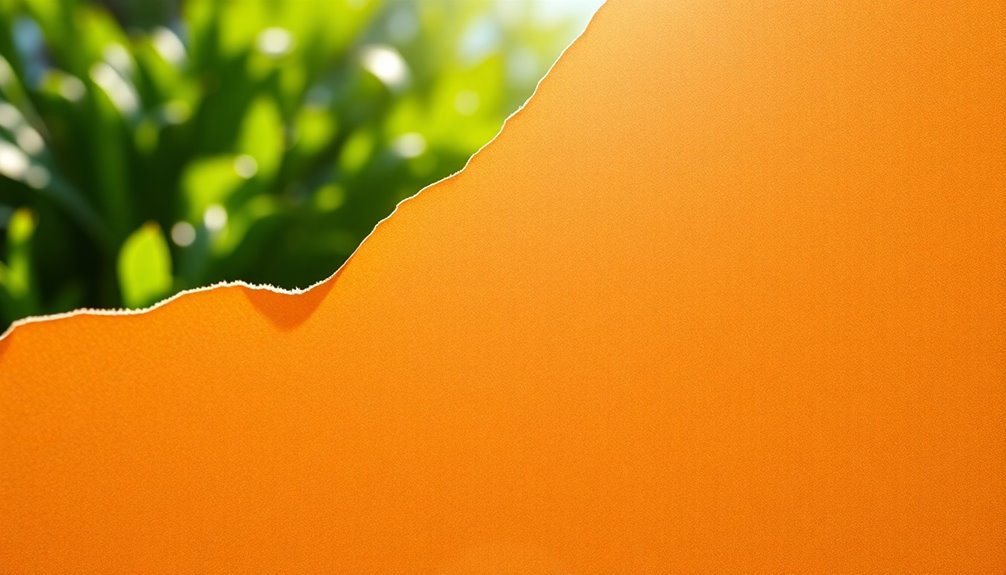
Made from wood pulp through the Kraft process, this paper is renowned for its high tensile strength and durability. The manufacturing process removes lignin, enhancing the cellulose content, which is key to its robustness. Its natural brown color comes from unbleached wood pulp, retaining strength since bleaching can weaken fibers.
Kraft paper features a coarse texture that's ideal for high-quality single-color printing, making it perfect for natural-themed branding. Additionally, it's lightweight, which means you'll enjoy lower shipping costs while still benefiting from excellent tear resistance and product protection.
Here's a quick overview of its key characteristics:
| Characteristic | Description | Eco-Friendliness |
|---|---|---|
| Strength | High tensile strength guarantees durability | Reduces waste through longevity |
| Color | Natural brown from unbleached pulp | Minimizes chemical use |
| Texture | Coarse, suitable for high-quality printing | Supports sustainable branding |
| Weight | Lightweight, reducing shipping costs | Less energy in transportation |
| Chemical Recovery | Recovers ~90% of pulping chemicals | Environmentally friendly process |
With these qualities, Kraft paper stands out as a sustainable and eco-friendly choice for various applications.
Benefits of Kraft Paper

Kraft paper offers a sustainable packaging solution that not only benefits the environment but also your bottom line.
Its cost-effective shipping advantages make it an ideal choice for businesses looking to reduce expenses while maintaining quality.
Plus, its versatility means you can use it for a wide range of applications, from wrapping gifts to creating eco-friendly mailers.
Sustainable Packaging Solution
Choosing kraft paper for your packaging needs offers numerous eco-friendly benefits that make it a standout option in sustainable packaging solutions.
First and foremost, kraft paper is 100% biodegradable and compostable, breaking down within weeks. This greatly helps minimize waste in landfills compared to plastic alternatives.
Moreover, the production process of kraft paper uses fewer chemicals and recovers about 90% of pulping chemicals, which minimizes environmental pollution.
When you opt for kraft paper, you're also supporting sustainable harvesting practices, as it's sourced from responsibly managed forests that often carry FSC certification.
Kraft paper's lightweight design not only leads to lower shipping costs but also reduces carbon emissions during transportation, contributing to an overall lower environmental footprint.
Its versatility means you can reuse it multiple times, further preventing waste accumulation and supporting a circular economy in packaging solutions.
Cost-Effective Shipping Benefits
Many businesses find that kraft paper offers substantial cost-effective shipping benefits. Its lightweight nature markedly reduces shipping costs compared to heavier materials, saving you money on transportation expenses. Plus, kraft paper's high tensile strength minimizes tearing during transit, ensuring your products stay protected and cutting down on costly replacements.
Kraft paper's durability allows for efficient stacking and packing, maximizing space in shipping containers. This efficiency further lowers your shipping costs. Here's a quick comparison of how kraft paper stacks up against other materials:
| Feature | Kraft Paper | Other Materials |
|---|---|---|
| Weight | Lightweight | Heavier |
| Tear Resistance | Highly Durable | Varies |
| Space Utilization | Excellent | Limited |
| Versatility in Use | Multiple Options | Often Limited |
Additionally, its natural texture enhances product presentation without the extra costs of elaborate packaging solutions. With its versatility for various packaging options, kraft paper simplifies inventory management and reduces overall packaging expenses for your business. Embracing kraft paper can lead to noteworthy savings while maintaining quality.
Versatile Applications and Uses
The advantages of kraft paper extend far beyond cost-effective shipping. Its strength and versatility make it a go-to choice for various applications. You'll find kraft paper used in many industries, from e-commerce to arts and crafts. Here are some benefits that highlight its versatility:
- Durability: Kraft paper's high tensile strength guarantees your packaging products are well-protected during transit, reducing the risk of damage.
- Cost-Effective: Its lightweight nature helps lower shipping costs, making it a smart option for businesses wanting to save money.
- Natural Appeal: The coarse texture of natural kraft paper gives a rustic, eco-friendly vibe, perfect for brands focused on sustainability and appealing to eco-conscious consumers.
- Eco-Friendly: As a 100% biodegradable and recyclable material, kraft paper is a sustainable choice that supports environmentally responsible practices and reduces landfill waste.
Whether you're packaging products, crafting, or shipping, kraft paper's multiple applications make it an indispensable resource.
Embracing kraft paper not only enhances your business's appeal but also aligns with eco-friendly values that today's consumers appreciate.
Common Applications
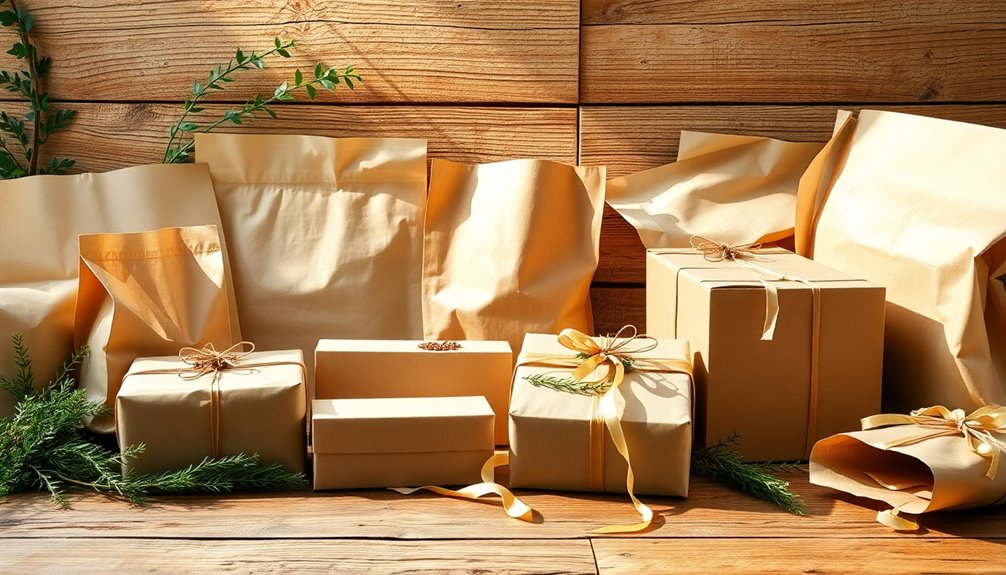
Kraft paper finds its way into a variety of applications that highlight its versatility and eco-friendliness. One of the most common uses is in Kraft paper packaging, where its high tensile strength makes it ideal for sturdy paper bags, boxes, and envelopes. Retailers and e-commerce businesses appreciate its durability, especially for shipping fragile items, ensuring reliable protection during transit.
In the food industry, kraft paper stands out due to its safety compliance and grease resistance, making it suitable for various food items. You'll notice it in takeout containers, sandwich wraps, and bakery bags, all aligning with today's consumer demand for eco-friendly options.
Moreover, kraft paper's natural color adds a rustic charm that many brands love for their packaging. It's also a popular choice in arts and crafts projects, allowing for creative packaging solutions and decorative uses.
Whether you're wrapping gifts or creating custom art pieces, kraft paper provides an excellent canvas. By choosing kraft paper, you're not only benefiting from its practical applications but also supporting sustainable paper manufacturing practices.
Eco-Friendly Properties

Choosing kraft paper for your packaging needs not only showcases its versatility but also highlights its eco-friendly properties.
You'll appreciate how this material contributes positively to the environment. Here are some key benefits of using kraft paper:
- Biodegradable: Kraft paper is made from natural fibers, decomposing within weeks, which greatly reduces waste compared to conventional materials.
- Sustainable Sourcing: It's made from renewable wood pulp sourced from responsibly managed forests, often bearing FSC certification, ensuring you support sustainable forestry practices.
- Lower Pollution: The manufacturing process uses fewer chemicals than traditional paper production, resulting in lower pollution levels and a smaller environmental impact.
- Recyclable and Compostable: Kraft paper is recyclable and compostable, enabling eco-friendly disposal methods that contribute to a circular economy.
- Additionally, opting for kraft paper can complement other green initiatives, such as solar energy solutions, enhancing overall sustainability in packaging practices.
Comparison With Butcher Paper
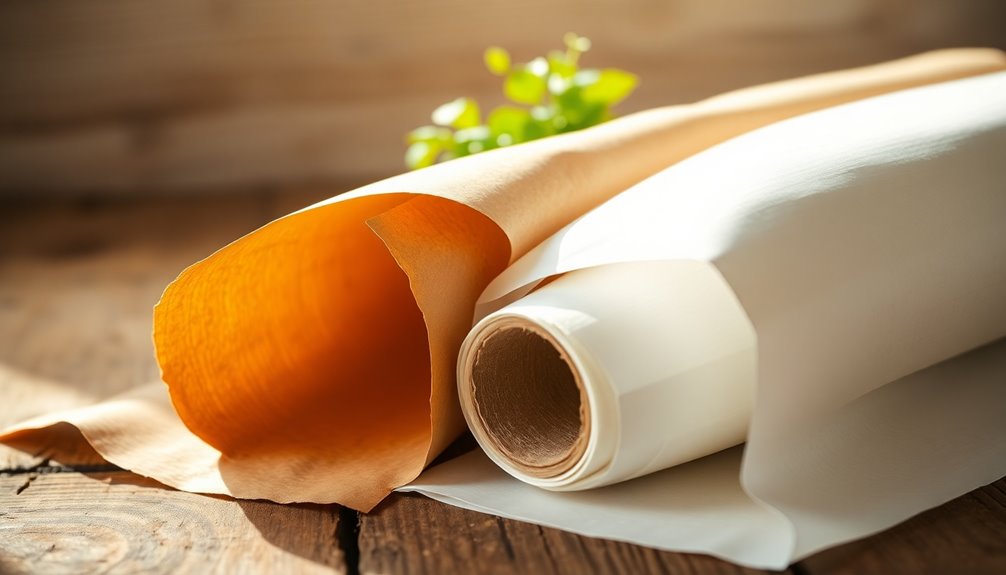
When you compare kraft paper and butcher paper, you'll notice key differences in their compositions and uses.
Kraft paper combines recycled and virgin wood fibers, while butcher paper relies solely on virgin pulp, making each suited for specific applications.
Understanding their moisture resistance and packaging capabilities can help you choose the right option for your needs.
Composition Differences Explained
In the world of paper products, understanding the composition differences between kraft paper and butcher paper is essential for making informed choices.
Here's a breakdown of their key differences:
1. Material Composition: Kraft paper is made from a mix of recycled Kraft paper and virgin wood fibers, while butcher paper relies solely on virgin wood pulp, lacking any recycled content.
2. Manufacturing Process: The manufacturing of kraft paper uses the kraft pulping method, which removes lignin and boosts strength. In contrast, butcher paper is typically coated to enhance moisture resistance.
3. Durability and Use: Kraft paper is known for its durability and versatility, ideal for various packaging applications.
Butcher paper, however, is mainly designed for wrapping meat and oily foods due to its specific properties.
4. Texture and Appearance: Kraft paper has a coarse, natural texture, making it perfect for stylish branded packaging.
Butcher paper features a smoother finish due to its coating, which caters to different aesthetic needs.
Moisture Resistance Features
Kraft paper offers impressive moisture resistance features that set it apart from butcher paper. Its dense fiber structure naturally provides a high level of moisture resistance, making it ideal for various packaging applications.
While butcher paper is specifically coated for wrapping meats and oily foods, kraft paper maintains its integrity when exposed to damp conditions, thanks to its cellulose content. This inherent moisture resistance allows you to use kraft paper in multiple scenarios, from shipping to crafts, without compromising performance.
If you stack multiple layers of kraft paper, its ability to protect contents during shipping and storage increases considerably. In contrast, butcher paper may lose its strength when wet, limiting its versatility.
Both kraft and butcher paper are recyclable, but the coating on butcher paper can complicate the recycling process. In contrast, kraft paper remains fully recyclable even when used in moist environments, making it a more sustainable choice overall.
Packaging Applications Comparison
Choosing the right packaging material can make a significant difference in both functionality and sustainability. When comparing kraft paper to butcher paper, you'll notice some key distinctions that can influence your packaging choices.
- Material Composition: Kraft paper is made from recycled and virgin wood fibers, making it more eco-friendly. Butcher paper, on the other hand, consists solely of virgin wood pulp, limiting its sustainable appeal.
- Versatility: Kraft paper features a porous surface, allowing it to package a wide range of products. Butcher paper is primarily designed for food items and is coated to resist moisture, restricting its use.
- Durability: Known for its high tensile strength, kraft paper is durable for various applications. Butcher paper is less robust, making it better suited for single-use purposes.
- Recycling Efficiency: Kraft paper is easier to recycle, while butcher paper's coating complicates recycling efforts, leading to increased waste levels.
In essence, if you're seeking an eco-friendly option that excels in versatility and durability, kraft paper is the clear winner over butcher paper for your packaging needs.
Customization Options
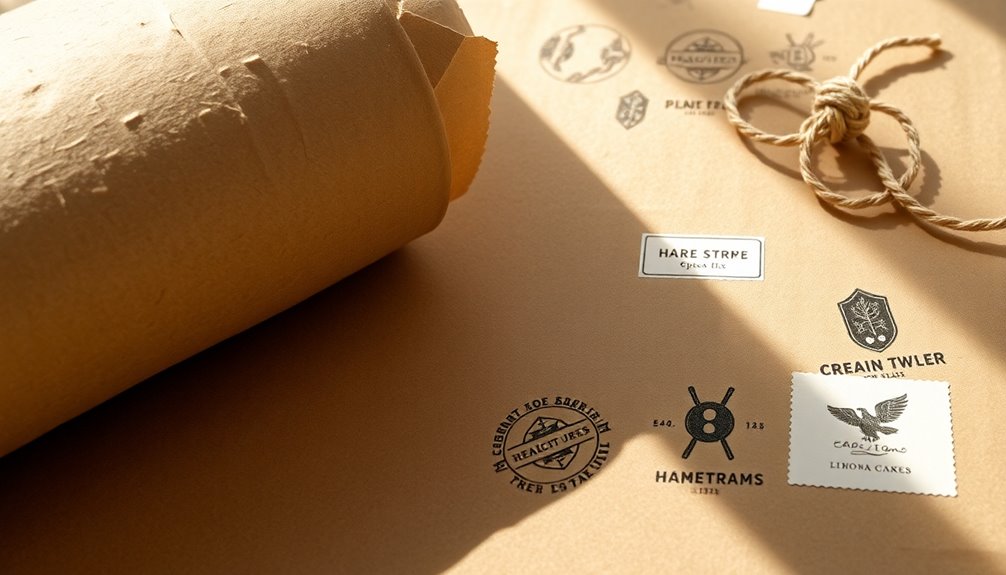
Customizing kraft paper opens up a world of possibilities for businesses looking to elevate their packaging. You can tailor custom kraft options in various dimensions and weights to suit your specific product needs, enhancing both presentation and functionality.
With custom printing, you can showcase your brand identity using vibrant designs printed with eco-friendly soy-based inks, ensuring your packaging stands out on the shelf.
You've also got the flexibility to choose different colors and finishes. Whether you prefer the natural look of unbleached kraft or the cleaner appearance of bleached options, the choice is yours.
Want to add a unique touch? Specialty features like embossing or foil stamping can create a tactile experience that captivates customers.
The versatility of kraft paper means you can develop branded packaging solutions that include bags, boxes, and tissue paper, making it perfect for a range of applications.
Case Studies and Examples
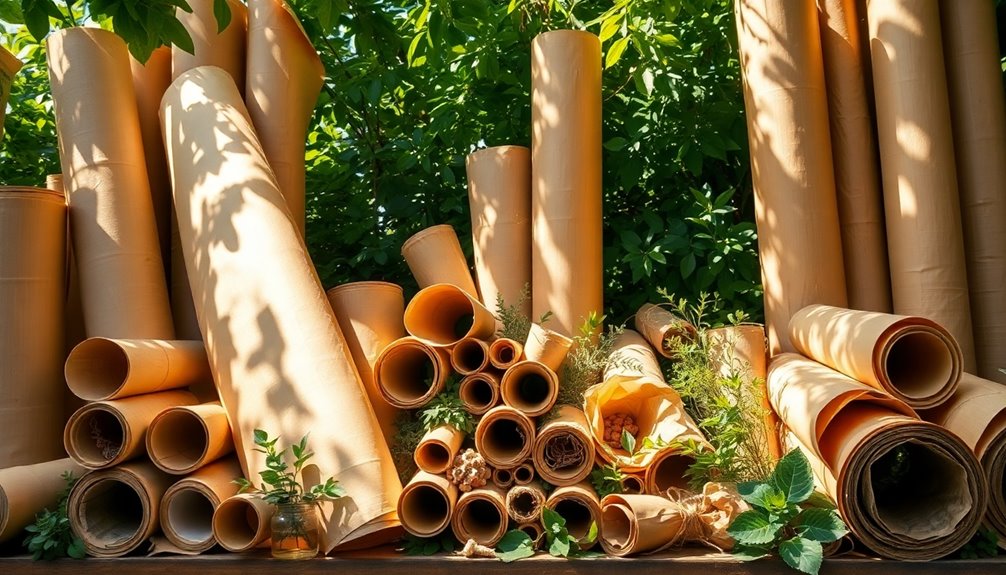
Let's explore how successful brands are implementing kraft paper in their packaging strategies.
You'll see innovative solutions from companies like T-Mobile and Adidas that not only enhance their eco-friendly image but also boost customer loyalty.
These case studies highlight the tangible benefits of choosing sustainable materials in a competitive market.
Successful Brand Implementations
In the domain of sustainable packaging, brands like T-Mobile and Adidas are leading the charge by implementing kraft paper solutions that not only reduce environmental impact but also resonate with eco-conscious consumers.
By embracing kraft paper, these companies have successfully enhanced their eco-friendly image while driving brand awareness.
Here are four notable benefits of using kraft paper:
- Reduced Carbon Footprint: Switching to kraft paper considerably lowers energy and water consumption during production.
- Increased Customer Loyalty: Brands utilizing sustainable solutions report higher customer satisfaction, as consumers prefer to support environmentally responsible companies.
- Versatile Marketing: Kraft paper's natural aesthetic allows brands to create visually appealing packaging that tells a story aligned with their values.
- Functional Design: Custom-printed kraft paper bags and boxes serve practical purposes while reinforcing brand identity.
These implementations demonstrate how integrating kraft paper into packaging strategies not only meets consumer demand for sustainability but also positions brands as leaders in eco-friendly practices.
Ultimately, adopting kraft paper is a smart move for any brand looking to strengthen its commitment to the environment while appealing to a growing market of conscious consumers.
Innovative Packaging Solutions
As brands seek to differentiate themselves in a competitive market, innovative packaging solutions like kraft paper are gaining traction. Companies like Adidas and T-Mobile have embraced kraft paper to enhance their eco-friendly solutions, showcasing their commitment to sustainability. A small artisanal chocolate brand found that switching to kraft paper not only cut costs but also boosted sales by attracting environmentally conscious consumers.
Kraft paper's versatility shines in various packaging designs, from custom-printed bags to shipping materials. The e-commerce sector, in particular, has reported a 20% reduction in shipping costs due to the lightweight nature of kraft paper. Additionally, its application in food packaging highlights its safety compliance while appealing to those seeking biodegradable options.
Here's a quick overview of successful kraft paper applications:
| Brand/Company | Application Type |
|---|---|
| Adidas | Eco-friendly packaging |
| T-Mobile | Shipping materials |
| Artisanal Chocolate | Retail packaging |
| E-commerce Sector | Shipping solutions |
These examples illustrate that innovative kraft paper packaging not only meets consumer demands but also aligns with sustainable practices, making it an ideal choice for modern brands.
Future of Kraft Paper
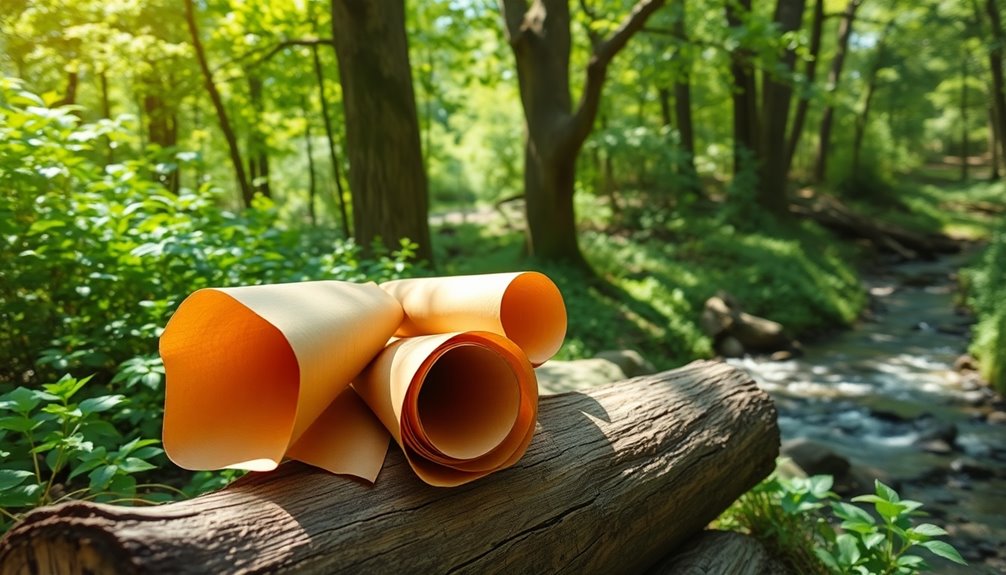
The future of kraft paper is bright, driven by a surge in consumer demand for sustainable packaging solutions. As you embrace more eco-friendly choices, you'll notice that innovations in kraft paper production are already in motion.
Here are some exciting trends to watch:
- Alternative Fibers: Manufacturers are exploring materials like bamboo and hemp, enhancing sustainability and reducing reliance on traditional wood sources.
- Market Growth: The global kraft paper market is projected to expand at a CAGR of about 4.5% from 2021 to 2026, reflecting increasing environmental awareness among consumers and businesses.
- Recycling Advances: Improved recycling technologies are boosting kraft paper recovery efficiency, promoting higher reuse rates and contributing to a circular economy.
- Brand Alignment: Companies are adopting kraft paper packaging to resonate with eco-conscious consumers, solidifying its place in future market trends.
Your choices can make a difference. By opting for kraft paper, you're not just choosing a product; you're supporting sustainable packaging that aligns with your values and helps create a greener planet.
Frequently Asked Questions
Why Is Kraft Paper Eco-Friendly?
Kraft paper's eco-friendly because it's 100% biodegradable and compostable, breaking down quickly and reducing landfill waste.
You'll appreciate that its production uses fewer chemicals, minimizing pollution while preserving wood fibers.
Plus, about 90% of the pulping chemicals can be recovered and reused, promoting resource efficiency.
With sustainably sourced wood pulp, kraft paper helps guarantee responsible forest management practices, making it a smart choice for environmentally conscious packaging solutions.
What Makes Paper Eco-Friendly?
When you consider what makes paper eco-friendly, think about its materials and production methods.
Eco-friendly paper comes from renewable resources like sustainably sourced wood pulp, reducing deforestation. It's biodegradable, breaking down naturally and minimizing landfill waste.
The manufacturing process uses fewer chemicals and less water, cutting pollution. Plus, many eco-friendly papers are recyclable, allowing you to repurpose them instead of relying on virgin materials for new products.
What Is Kraft Paper Made Of?
Kraft paper's made from wood pulp, primarily sourced from renewable trees like pine and bamboo.
In the production process, the Kraft pulping method separates cellulose from lignin using sodium sulfide and sodium hydroxide. This method guarantees a high cellulose content, giving the paper its strength and durability.
Since it's usually unbleached, you'll notice the natural brown color, which means fewer harmful chemicals are used, making it a solid choice for eco-conscious projects.
Is Kraft Paper 100% Recycled?
Kraft paper isn't always 100% recycled. While some products use entirely recycled materials, others blend virgin and recycled fibers for added strength.
If you're looking for eco-friendliness, you might prefer unbleached kraft paper, as it skips harmful chemicals.
Remember, kraft paper can be recycled multiple times, making it a sustainable option overall.
Conclusion
To sum up, kraft paper stands out as an eco-friendly choice due to its sustainable production process and versatility. Its durability and biodegradability make it ideal for various applications, from packaging to arts and crafts. By choosing kraft paper, you're not just opting for a practical solution but also supporting environmental sustainability. As industries continue to innovate, the future of kraft paper looks bright, promising even more eco-conscious options for consumers like you.


